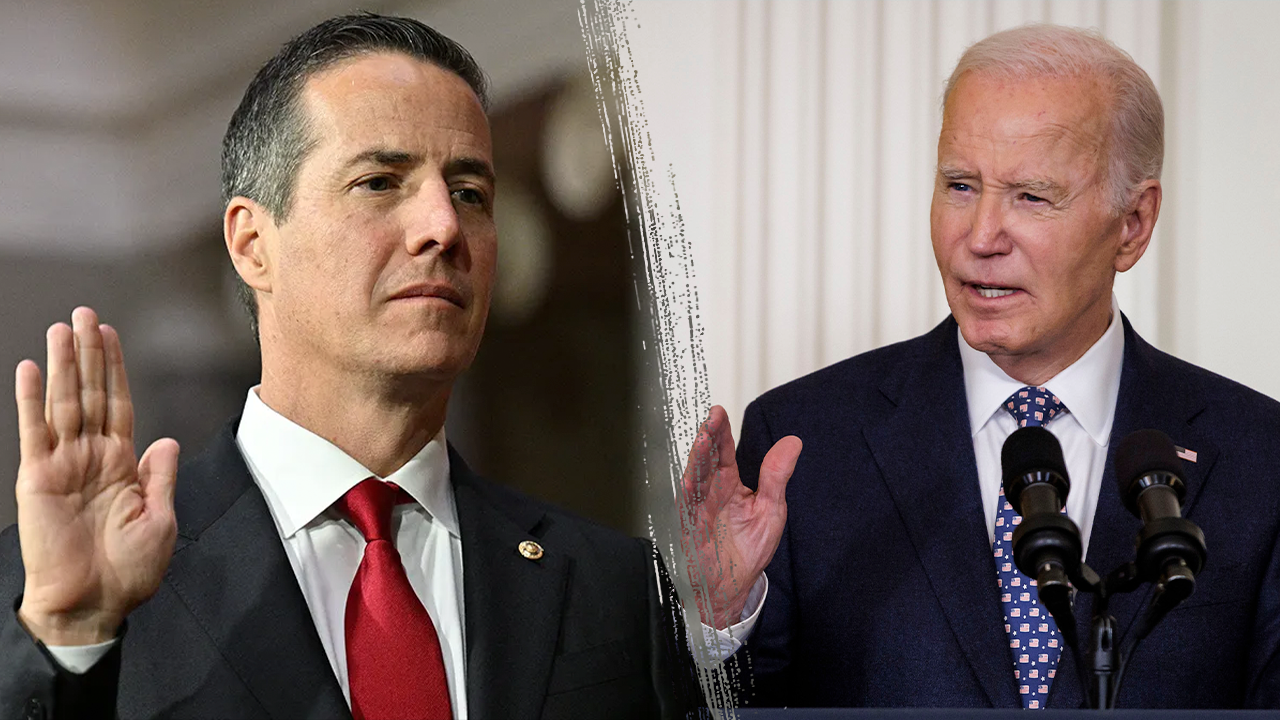South Dakota
Decoying Prairie Bucks with Dad

We awoke to a howling wind beating against our uninsulated 14-foot enclosed trailer. As I sat up, my breath hung in the air like a fog. I fumbled around for a lighter to spark the propane buddy heater and noticed that the internal thermometer was resting at 24ºF.
“Welcome to South Dakota,” I said to my dad, who was about to embark on the first Western hunt of his life.
We knew it was going to be cold, but our weather app didn’t predicted the arctic storm that had turned a welcoming autumn prairie into a frozen landscape.
As I stepped out to brush my teeth, I was met by subzero temperatures and a 30-mph sustained wind that stung my face. There was a 1-inch coating of ice on everything from the barbed wire fence we had parked alongside to the sage brush meadow we would be hunting.
We fired up the Coleman propane burner and I cracked a few eggs into the pan. As the eggs were just about to finish up, the flame on the burner went out. Not thinking much of it, I swapped propane canisters and tried to restart the stove, but to no avail. Heck, the lighter wasn’t even sparking. I held the lighter up to my face and clicked it again, producing a flame almost immediately. As I slowly moved it toward the burner, it was magically snuffed out again. That’s when I realized we were running out of oxygen, and fast. In our haste to heat things up in the trailer, we had forgotten to open the vents and nearly ended the trip early with carbon monoxide poisoning.
At this moment I knew that we’d be making lots of memories on this trip — if we survived it.
Learning the Hard Way
Photo by Derek Horner
During the three previous deer seasons, I had spent a week in November hunting my way across the prairie with my bow. Coming from the big woods of Pennsylvania, the South Dakota landscape might have felt like the moon: flat and lifeless.
But there were more deer than I ever thought possible. Glassing from a little high point could lead to seeing 30 to 40 deer at a time, with some giant muleys in the mix. But the nearly featureless terrain made closing that distance a real challenge. With a rifle, those week-long excursions would have ended by day two or three; with a bow, I spent day after day belly crawling hundreds of yards just to get busted as I sat up to draw.
It took three seasons for me to kill my first prairie buck — a nice whitetail — and I did so out of pure luck. But the success gave me the confidence to finally invite along the man who taught me to deer hunt. I hoped I could now help my dad find success in this wide open country.
Into the Frozen Fog
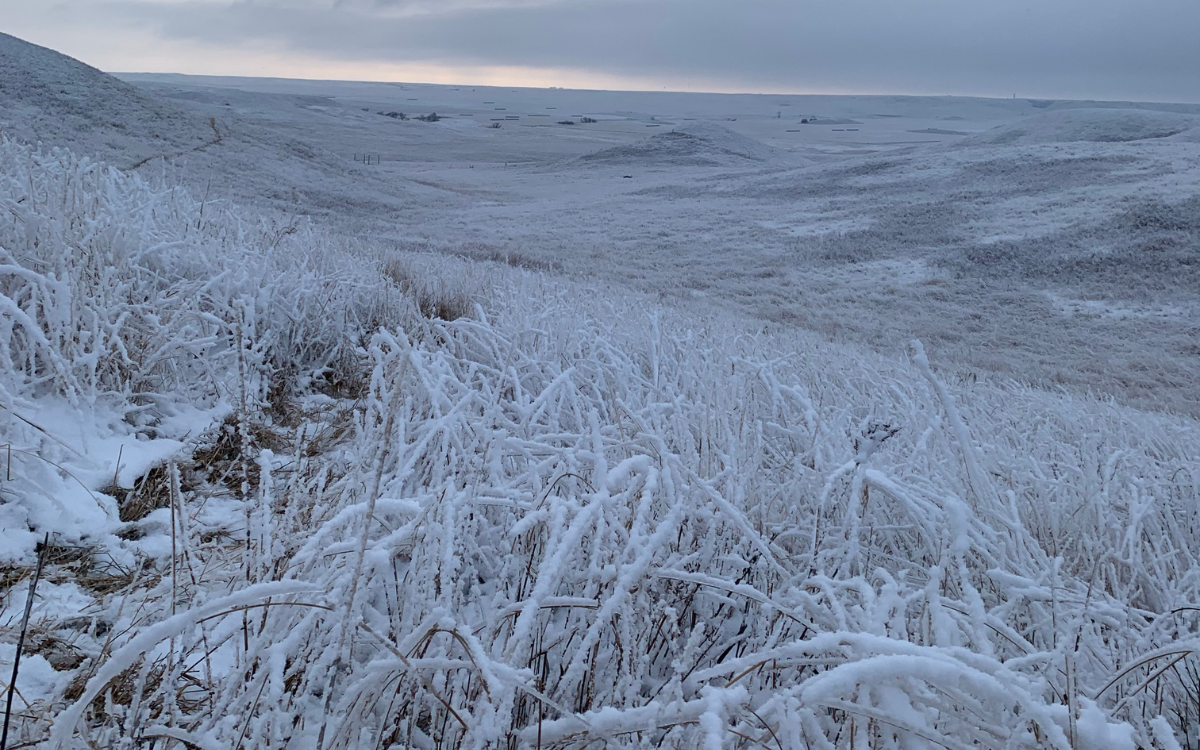
Photo by Derek Horner
After we opened the vents of the trailer and made sure we had enough oxygen flowing, we finished breakfast and put on the rest of our layers. Emerging from the trailer looking like camouflaged Michelin men, we took our first few steps into the prairie. Almost immediately, I knew we were in trouble.
Each step we took produced a thunderous crash of ice. It sounded like we were smashing glass Coke bottles with every move.
“How on Earth are we ever going to close the gap on a mule deer when they can hear us coming from a mile away?” my dad asked.
“I guess we’re going to find out,” I replied.
As I pondered our predicament, another obstacle presented itself. Just as daylight broke, a dense fog started to set in. It was one of the weirdest fogs I’d ever experienced. The wind hadn’t let up and the real feel was somewhere near -30ºF, but we couldn’t see more than 10 feet in front of us. The small creek bottom we planned to glass was only 200 yards away, but it was totally obscured. We decided that our best play was to sit and wait it out.
After about 20 minutes, we were both shaking from the brutal cold so we took turns walking along the backside of the glassing knob to warm up. When the fog finally lifted enough to see the creek bottom, we were sorely disappointed to see three other hunters creeping along both sides of the creek.
We packed up and headed to the next waypoint on the map.
Winter Wonderland
I knew that there were deer in our new area from prior trips, but I was stunned by how many appeared at our first glassing knob. Every draw seemed to have a herd of mule deer. I’m not sure why, but it was as if every deer in the state was packed into this mile-long corridor of hills.
We set up the spotting scope quickly, and within a minute or two, I was directing my dad’s attention to a long and narrow draw about 800 yards to our right. Bedded within the draw was a giant 6×5 buck with a harem of does. When my dad saw the buck his eyes lit up and we quickly began crafting a plan for his first stalk.
Due to the lack of cover, he would have to back off of our glassing knob and make a ¾-mile loop around the hills to remain out of sight. We planned his final approach as well, picking out a rock as a landmark to guide him in. I’d stay back with the spotter to watch.
After what felt like an eternity of sitting there waiting for him to pop back up near the draw, I finally caught a glimpse of movement as he made the final approach. Somehow, even with the glass-crushing icy conditions, he was able to get within 100 yards of the bedded buck. Then 90 yards, 80 yards… 70 yards. Crawling on his hands and knees it seemed as though my 52-year-old dad was going to get a crack at this deer. Then, heartbreak. One of the does in the group had heard enough and busted out, taking the whole herd with her.
It was a scene I had experienced countless times in the years prior, but it felt different watching the disappointment in my dad as he hiked back to our glassing knob.
“I really thought I had a chance there, what’d I do wrong?” he asked.
The answer was that he’d done everything right, and the only thing to do was try again.
Decoy Tactics
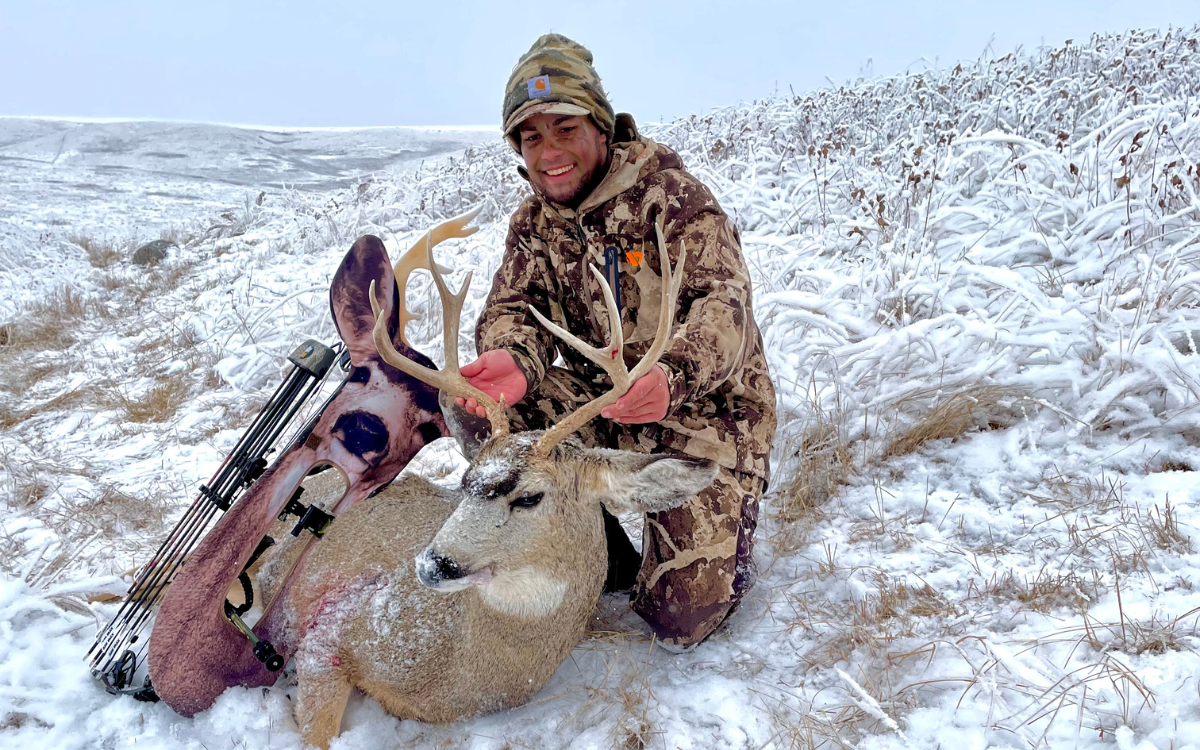
Photo by Derek Horner
From there, we went on a streak of bad luck. For days, stalk after stalk, we’d just keep getting busted on the edge of bow range. The crunchy ice made closing the final 10- to 20-yards a seemingly impossible task. It was time to go back to the drawing board.
There were plenty of deer, and lots of quality bucks worth chasing. So, I decided to throw caution to the wind and try a new tactic: a bow mounted decoy system that my girlfriend had gifted me. I thought it just might be crazy enough to work.
Read Next: Best Deer Decoys
On the fourth day of our trip, as we sat on a glassing knob enjoying our coffee in the -20ºF real feel, I spotted a small 2×3 chasing a doe at the bottom of a series of draws. It seemed like the perfect opportunity to test out the bow decoy. After a short approach, I came into view 80 yards away, the small buck snorted at me and began raking the sagebrush and stomping. He then trotted toward me and stopped at 25 yards. I was in awe. Not only was the buck in bow range, but it genuinely believed I was another deer.
“This thing is totally going to work,” I told my dad.
That afternoon, we approached a new glassing knob and spotted a nice 4×4 locked down with a doe about a half-mile away.
I stalked into a basin about 350-yards away from the bedded couple. As I began to slowly scoot forward with the decoy up, a decent 3×3 crested the hill and walked right into their draw.
The two bucks did a few circles around each other before locking up and having a 30-second knock-down, drag-out brawl. The 4×4 was able to flip the 3×3 on his side, ending the battle. Once the 3×3 vanished out of sight, the 4×4 took a few seconds to shake off and recover, then he locked onto my decoy.
Suddenly, he was sprinting at me — 150 yards away, 100 yards, 50 yards, and then he disappeared behind a dip in the terrain. But I could still hear him crashing through the sage. He popped out at 25 yards and stopped. He pinned his ears back and let out a deep, guttural groan. Then, he started slowly circling me, raking the ground with his hoof.
At 15 yards, he stopped and lowered his head to rake the sage with his antlers. I took the chance to draw and settled my pin on the crease of his shoulder. As he took one more step, he opened his vitals and I released.
Photo by Derek Horner
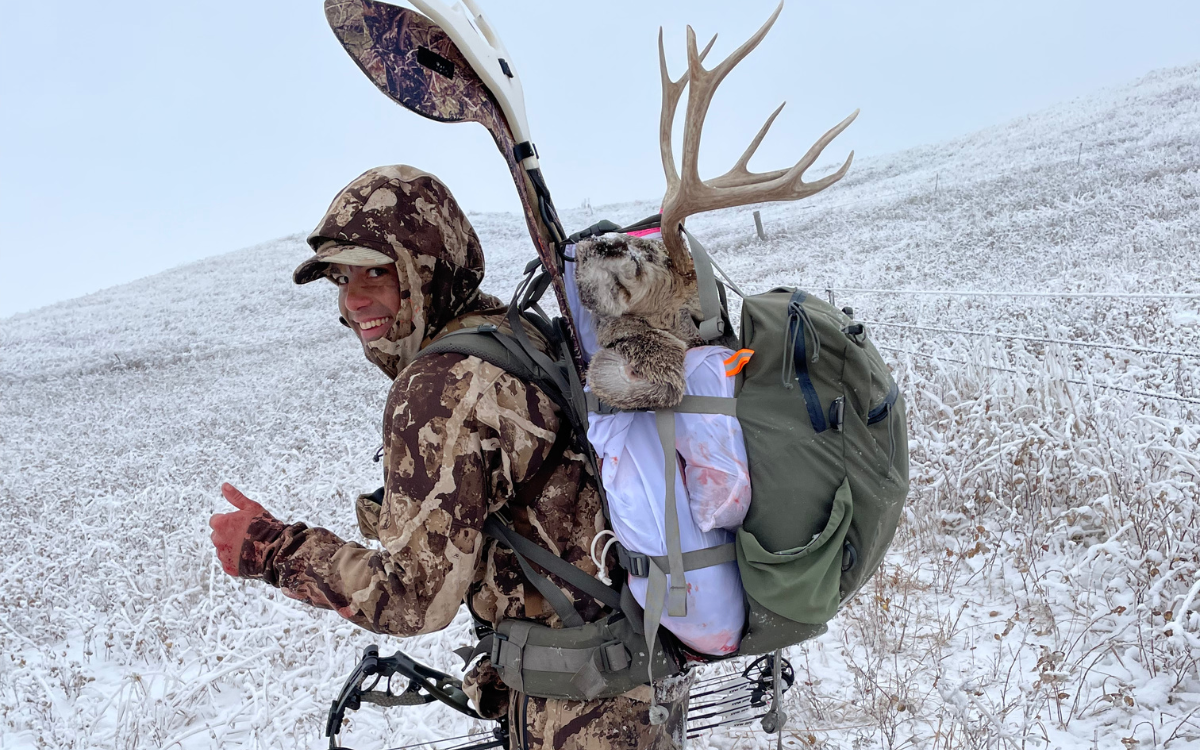
The arrow hit its mark and passed through, but somehow the buck didn’t seem to notice. He took two more steps toward me before expiring. Once he hit the ground, time stood still. My four-year journey to tag a mule deer with my bow was complete, and it was that much sweeter to have my dad with me to experience it.
Read Next: Mule Deer Hunting Tips
We quartered the buck and packed him out just before darkness settled. That night we celebrated in town with burgers and beers. The heater next to our table helped thaw us out as we relived the hunt, over and over.
A Final Stalk on the Final Day
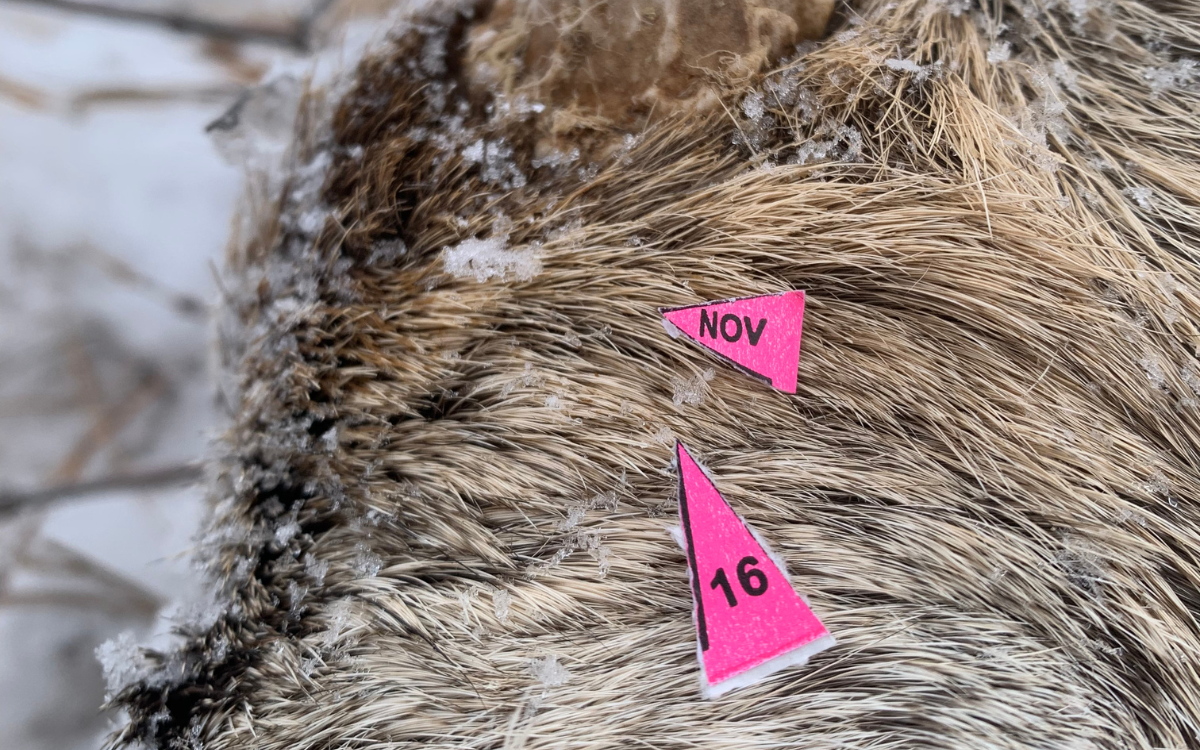
Photo by Derek Horner
Over the next few days my dad had more long stalks and close calls but never got into range of a shooter buck. As the sun crested the horizon on our final day, the meadow around our glassing knob glistened like a chandelier. Things just felt right.
We spent the majority of the morning, into the afternoon, glassing for a single buck locked down with one doe. We had decided that the bucks holding down a harem of does had too many eyes guarding them. If we were going to spend the time stalking, it needed to be the right situation.
As the late afternoon approached, we had seen plenty of nice bucks off in the distance, but each one had six or seven does by their side. It was beginning to feel like the magic of the final day was running out. In a last-minute decision with about an hour and a half of daylight left, we decided to drive 20 minutes south to another walk-in spot where we had glassed bucks previously. As we approached our parking spot, we looked across the prairie. As if God himself had placed him there for us, there stood a buck: a big 3×3 tending a single doe.
They were about 600 yards away, and there wasn’t any way to make a stealthy approach. They were on a slight rise in the middle of a giant flat, so we sat and pondered for a few minutes.
“There’s no way they let me walk out across the open to them without spooking at some point, right?” Dad asked me.
“I don’t see any other options,” I said, trying to sound as encouraging as possible.
Deep down, I had the same feeling he did. There was a lot of open ground to cover, and even with the decoy, they’d be watching him the entire way.
“Well, no time like the present,” he said, chuckling as he strapped on the decoy and stood up to begin his stalk.
I stayed put, watching from our elevated position as he made his way down the hill and onto the flat. The deer locked in on him and were staring hard as he slowly crept along. At 400-yards, he stopped to relax his arm for a few seconds. The buck and doe were still intently watching, but not showing signs of concern.
He continued forward, 300 yards, 200 yards, 100 yards… the deer still watching every step. Once he broke the 70-yard mark, my heart began to pound.
Holy shit, he’s actually got a chance here.
The wind was howling, so my dad continued pushing, trying to get as close as they would allow. At 60 yards, he slowly and carefully nocked an arrow. The deer were still keeping an eye on him, and I could see the doe was becoming agitated. He gained five more yards before she stood up.
In an instant, the buck stood too, and I watched my dad draw. My position was perfect for having both the buck and my dad in the spotting scope at the same time. Suddenly, the buck mule-kicked and took off to the west; his doe was left standing there wondering what had happened. I’d never seen the arrow and neither had she.
Photo by Derek Horner
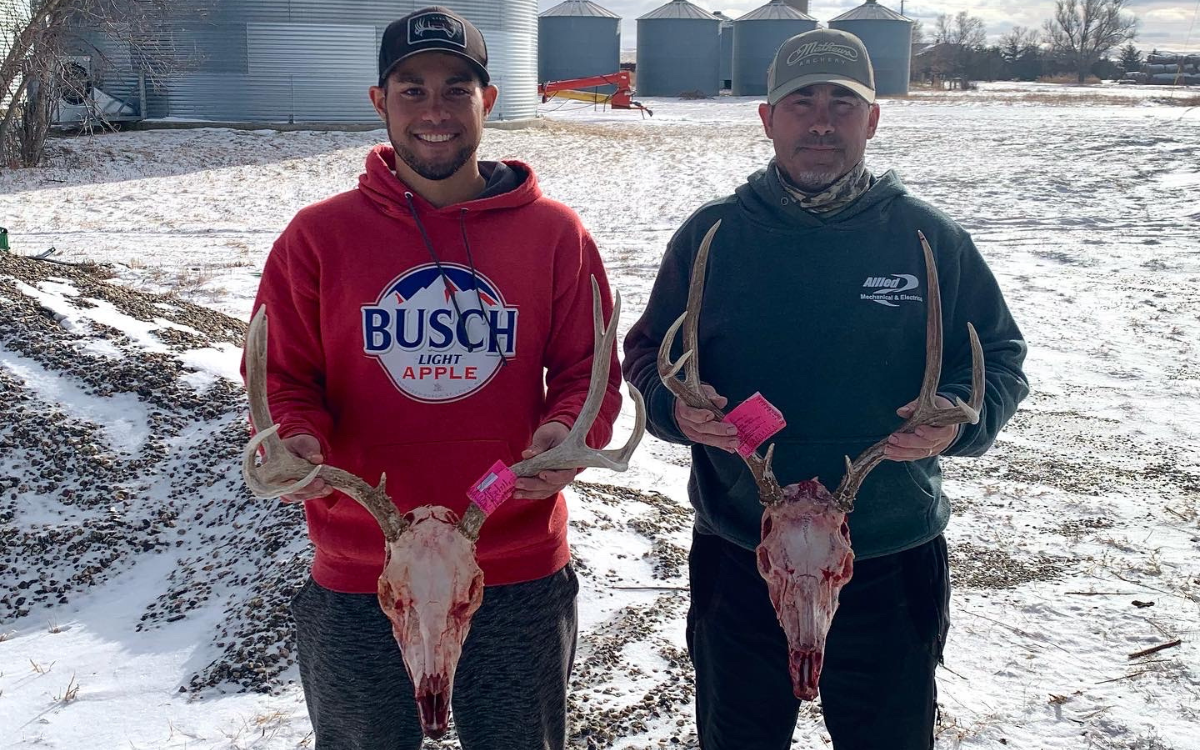
I tracked the buck with the spotting scope and could see a trail of blood in the snowy prairie grass behind him. After about 150 yards, he bedded down. Not long after, I watched through the spotter as he expired. I had been giving my dad hand signals to just wait where he was, but once the buck put its head down for a final time, I fist pumped and took off running down the hill and tackle-hugged him into the snow.
It was the toughest week of hunting either of us had ever had. And that final hour, of the final day, was one of the sweetest moments we’ve ever shared. Most days I find myself daydreaming about the end of that frozen hunt, but especially on Father’s Day.

South Dakota
South Dakota attorney general unveils package of new laws for 2025 legislative session
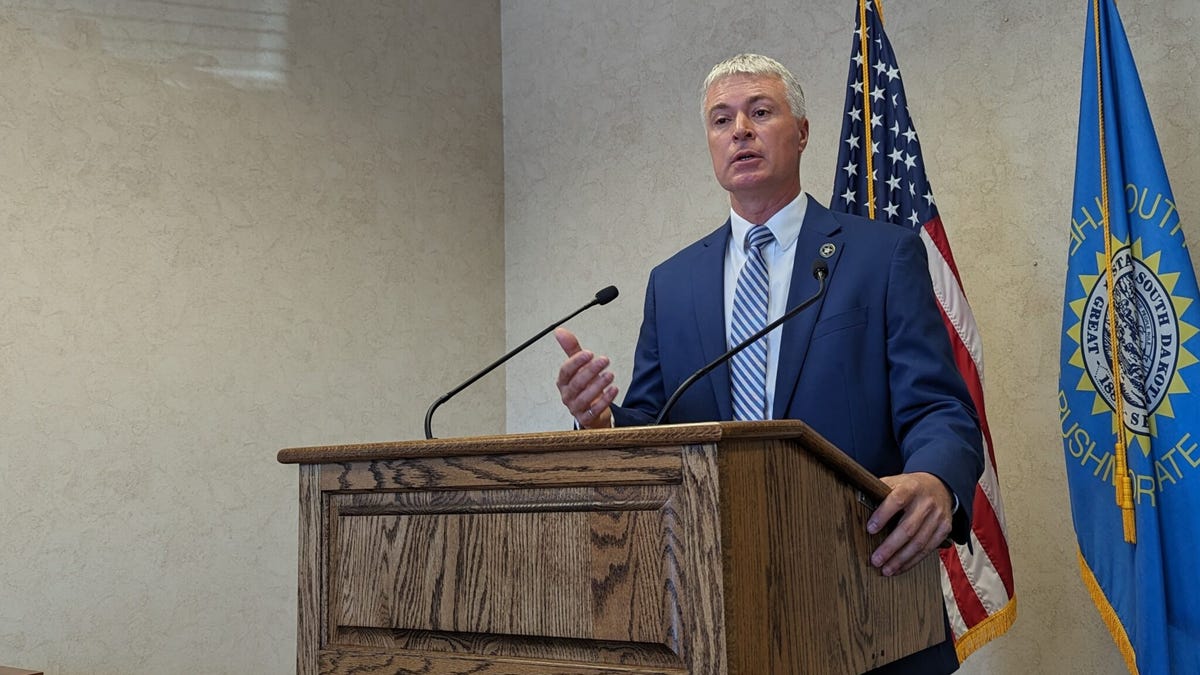
Boys and men are also victims of sex trafficking
Could this be the beginning of a broader reckoning for male victims of this crime?
South Dakota Attorney General Marty Jackley hopes to prevent and catch future criminal conduct by state employees with new reporting requirements, protections for whistleblowers and a bigger role for the state auditor, according to a package of legislation he released Tuesday.
Jackley unveiled seven bills for lawmakers to consider during the annual legislative session that kicks off next Tuesday at the Capitol in Pierre.
Jackley’s bills focus on government accountability, human trafficking, prison contraband and probation.
Government accountability
Jackley’s government accountability measures come in response to several prosecutions he began last year against former state employees.
Those cases include allegations of former Department of Revenue employees creating fake vehicle titles to secure loans and avoid excise taxes, a former Department of Social Services employee allegedly embezzling $1.8 million, and a former Department of Public Safety employee allegedly filing fake food-service health inspection records for inspections that were never conducted.
“Protecting taxpayer dollars and restoring the public’s trust in government should be given high priority,” Jackley said Tuesday in a press release.
One of his proposed measures would require state employees in supervisory roles to report suspected unlawful conduct to the attorney general and state auditor. Failure to report suspected violations would be classified as a felony.
Additionally, the attorney general would be required to submit an annual report to lawmakers on the state budget committee outlining the number and outcomes of misconduct reports received.
Another bill seeks to shield state employees from retaliation for reporting misconduct or participating in audits and investigations. The bill would:
- Prohibit state supervisors from discharging, discriminating against or taking any other retaliatory action against whistleblowers.
- Establish a process allowing state employees to file complaints with the attorney general within two years after experiencing retaliation.
- Authorize courts to reinstate employees and award back pay if they suffered illegal retaliation.
A third measure would authorize the state auditor to access all financial records of every state agency to conduct audits, investigate improper conduct and ensure internal controls are in place and maintained.
The fourth bill proposes state agencies conduct mandatory annual risk reviews, with results submitted to the Board of Internal Control. The reviews would assess agencies’ risk management practices and identify vulnerabilities.
Human trafficking
Another proposal would revise human trafficking laws and prohibit the obstruction of their enforcement.
“Human trafficking remains a national concern that we are not immune from, and this legislation strengthens victim protections and enhances our ability to hold offenders accountable,” Jackley said.
The bill would update the definitions of human trafficking in the first degree and second degree and would:
- Establish mandatory minimum prison sentences of 15 years for a first offense and 20 years for a second or subsequent offense of human trafficking in the first degree.
- Establish mandatory minimum prison sentences of five years for a first offense and 10 years for a second or subsequent offense of human trafficking in the second degree.
- Create the new felony crime of obstructing the enforcement of human trafficking laws.
Prison contraband
Jackley’s legislative package also includes measures dealing with contraband in state correctional facilities. Officials with the state Department of Corrections reported finding contraband during a lockdown last year at the penitentiary in Sioux Falls.
Existing laws prohibit inmates from possessing drugs, unapproved prescription drugs, alcohol and weapons. Among other provisions, the proposed legislation would add unapproved cell phones and electronic communication devices to the list of banned items, clarify that employees and other people are prohibited from giving a similar list of items to inmates, and adjust the severity of various penalties for the different types of contraband.
Presumptive probation
Another proposal addresses South Dakota’s presumptive probation system, which mandates that some non-violent offenders receive probation instead of prison time. Jackley’s bill would make re-offenders who were already on probation or parole supervision ineligible for presumptive probation.
The bill also adds those convicted of threatening public officials or fleeing law enforcement to the list of ineligible offenders, as well as sex offenders who violate safety zones.
“Sentencing courts need more flexibility to impose appropriate sentences for certain violent offenders, and those choosing to reoffend while on probation or parole,” Jackley said.
South Dakota Searchlight is part of States Newsroom, the nation’s largest state-focused nonprofit news organization.
South Dakota
Landowners appeal Summit carbon storage decision • South Dakota Searchlight

A group of North Dakota landowners is appealing the state’s approval of an underground carbon storage area for Summit Carbon Solutions, the company attempting to build the world’s largest carbon capture and storage project.
The group represented by Bismarck attorney Derrick Braaten on Thursday filed the appeal in Burleigh County District Court, asserting that the North Dakota Industrial Commission withheld information and violated state law in approving the storage permit plan on Dec. 12.
The permanent underground carbon storage sites in western North Dakota are a key piece of Summit’s planned five-state pipeline network (including South Dakota) capturing greenhouse gas emissions from ethanol plants. Approving the storage wells was one of the last decisions of Gov. Doug Burgum as chair of the Industrial Commission, which also included Attorney General Drew Wrigley and Agriculture Commissioner Doug Goehring.
State schedules public input meetings on Summit carbon pipeline application
The unanimous vote by the commission means that landowners who had not signed an agreement with Summit will be forced to allow the carbon storage on their property.
The landowners assert that the Industrial Commission, which includes the state Department of Mineral Resources, illegally refused to disclose information to landowners under North Dakota open records laws. Braaten and his clients were seeking computer-generated models that predict where the carbon dioxide will go when it is pumped underground for permanent storage.
The appeal says former Department of Mineral Resources Director Lynn Helms refused to provide the models before, during and after public hearings on the case in June, shortly before Helms retired.
The order passed by the Industrial Commission said that if any open records requests were not fulfilled, it is because the Braaten Law Firm did not inform the agency that it had not received the records.
“That’s a lie,” Braaten told the North Dakota Monitor.
The appeal said Braaten’s firm was able to obtain the records in November. Braaten contends the computer models aren’t accurate but landowners were not given a chance to dispute that. He said multiple requests for a rehearing were ignored.
Another issue raised in the appeal are the state’s rules on underground storage. Under a process called amalgamation, if 60% of the landowners in a proposed storage area agree to the plan, the state can force the other 40% to comply.
Summit has obtained more than 92% of the pore space lease agreements across all three areas, according to the order approved in December.
GET THE MORNING HEADLINES.
After the commission’s Dec. 12 decision, Summit Executive Vice President Wade Boeshans said the permits resulted from “years of rigorous scientific study, engineering design, and input from regulators, landowners, and local leaders.”
Braaten also is representing the Northwest Landowners Association that has a separate lawsuit before the North Dakota Supreme Court on the amalgamation issue that he contends is unconstitutional.
He said a ruling on either that lawsuit or the storage decision appeal should clarify the constitutionality of the rules.
Braaten’s law firm also is representing Emmons County in a separate legal challenge to the state Public Service Commission’s approval of the pipeline route through North Dakota. Emmons County and Burleigh County are challenging the PSC’s interpretation of state law that concluded state zoning rules preempt local ordinances on where pipelines are allowed.
Another group of landowners also is appealing the PSC permit decision.
Braaten said those appeals may be combined into one case.
South Dakota
Former South Dakota DSS employee indicted for allegedly stealing voucher to buy groceries

A former South Dakota Department of Social Services employee was indicted on one count of social services fraud Thursday, according to a press release from the South Dakota Attorney General’s Office.
Amalia Escalante Barrientos, 28, allegedly used a stolen DSS voucher to purchase groceries for personal use, according to the press release. The incident occurred at a Brookings business Oct. 11.
The Brookings woman has not yet appeared for an initial hearing, according to Minnehaha County court documents.
According to Open SD, Barrientos’ wage is listed at $26.58 hourly.
If convicted, Barrientos could serve up to one year in the county jail, a $2,000 fine, or both, according to the press release.
-

 Business1 week ago
Business1 week agoThese are the top 7 issues facing the struggling restaurant industry in 2025
-

 Culture1 week ago
Culture1 week agoThe 25 worst losses in college football history, including Baylor’s 2024 entry at Colorado
-

 Sports1 week ago
Sports1 week agoThe top out-of-contract players available as free transfers: Kimmich, De Bruyne, Van Dijk…
-

 Politics1 week ago
Politics1 week agoNew Orleans attacker had 'remote detonator' for explosives in French Quarter, Biden says
-

 Politics1 week ago
Politics1 week agoCarter's judicial picks reshaped the federal bench across the country
-

 Politics6 days ago
Politics6 days agoWho Are the Recipients of the Presidential Medal of Freedom?
-

 Health5 days ago
Health5 days agoOzempic ‘microdosing’ is the new weight-loss trend: Should you try it?
-

 World1 week ago
World1 week agoIvory Coast says French troops to leave country after decades












